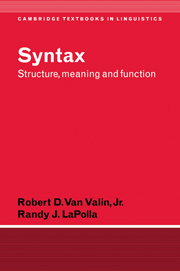Book contents
- Frontmatter
- Contents
- List of figures
- List of tables
- Acknowledgments
- Notes for instructors
- List of abbreviations
- 1 The goals of linguistic theory
- 2 Syntactic structure, I: simple clauses and noun phrases
- 3 Semantic representation, I: verbs and arguments
- 4 Semantic representation, II: macroroles, the lexicon and noun phrases
- 5 Information structure
- 6 Grammatical relations
- 7 Linking syntax and semantics in simple sentences
- 8 Syntactic structure, II: complex sentences and noun phrases
- 9 Linking syntax and semantics in complex sentences
- Epilog: the goals of linguistic theory revisited
- Notes
- References
- Index of languages
- Subject index
1 - The goals of linguistic theory
Published online by Cambridge University Press: 05 June 2012
- Frontmatter
- Contents
- List of figures
- List of tables
- Acknowledgments
- Notes for instructors
- List of abbreviations
- 1 The goals of linguistic theory
- 2 Syntactic structure, I: simple clauses and noun phrases
- 3 Semantic representation, I: verbs and arguments
- 4 Semantic representation, II: macroroles, the lexicon and noun phrases
- 5 Information structure
- 6 Grammatical relations
- 7 Linking syntax and semantics in simple sentences
- 8 Syntactic structure, II: complex sentences and noun phrases
- 9 Linking syntax and semantics in complex sentences
- Epilog: the goals of linguistic theory revisited
- Notes
- References
- Index of languages
- Subject index
Summary
Introduction
This book is about some of the devices users of human languages employ to put meaningful elements together to form words, words together to form phrases, phrases together to form clauses, clauses together to form sentences, and sentences together to form texts. The emphasis here will be on the construction of units larger than words, in particular clauses and sentences. This has often been viewed primarily as the domain of syntax. ‘The term “syntax” is from the Ancient Greek sýntaxis, a verbal noun which literally means “arrangement” or “setting out together”. Traditionally, it refers to the branch of grammar dealing with the ways in which words, with or without appropriate inflections, are arranged to show connections of meaning within the sentence.’ (Matthews 1982:1). The expressions of a language involve a relationship between a sequence of sounds and a meaning, and this relationship is mediated by grammar, a core component of which is syntax. In English and many other languages, the arrangement of words is a vital factor in determining the meaning of an utterance, as illustrated in (1.1).
(1.1) a. The man saw the woman.
b. The woman saw the man.
In Dyirbal (Australia; Dixon 1972) and many other languages, however, the order of words is irrelevant to the determination of the meaning of a sentence; it is, rather, the inflectional form of a phrase which is the crucial factor determining the interpretation of the sentence, as shown in (1.2). (The base forms of each noun are italicized.)
- Type
- Chapter
- Information
- SyntaxStructure, Meaning, and Function, pp. 1 - 16Publisher: Cambridge University PressPrint publication year: 1997

